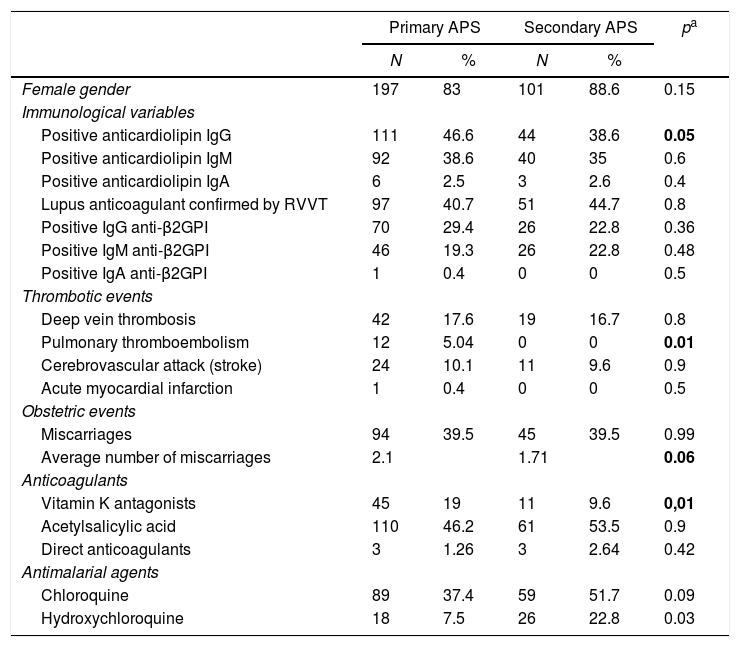Antiphospholipid syndrome (APS) is a systemic autoimmune disease characterized by recurrent thrombosis that can affect the arterial and venous circulation.
ObjectivesTo analyze the immunological and pharmacological differences, as well as the clinical outcomes of a cohort of patients with primary antiphospholipid syndrome and secondary antiphospholipid syndrome.
Materials and methodsA retrospective cohort study was conducted that included 352 records of patients diagnosed with APS and treated between 2014 and 2018. A description is presented of the sociodemographic, clinical, and immunological profile of the population. A bivariate analysis performed using the chi-squared test to determine differences between groups with primary APS and secondary APS, and finally a multivariate analysis to search for associations with thrombotic clinical outcomes in patients with APS.
ResultsThe mean age was 42.4 ± 14 years, and 84.6% were females. Two-thirds (67.6%) of the patients had a diagnosis of primary APS, and 32.4% of secondary APS, of which 84% were associated with systemic lupus erythematosus (SLE). Among the thrombotic events, the most frequent were deep vein thrombosis (17.3%) and stroke (9.9%). Obstetric events were frequent, with a prevalence of 39.4% for miscarriages. No differences were found in the sociodemographic or immunoserological profile when comparing the group of primary vs. secondary APS. Thrombotic events were more frequent in the primary APS group, although only pulmonary embolism reached statistical significance. There were no differences between the two groups as regards obstetric events, such as miscarriages. Women were found to be 5 times more likely to have a stroke and 3 times more to have deep vein thrombosis. The anti-B2GPI type IgM increased the probability of presenting miscarriages about 3 times in women with APS.
ConclusionThe study contains one of the largest Colombian cohorts with APS reported so far, and although it is both clinically and sociodemographically similar to other cohorts, there is a higher prevalence of primary APS. There was a lower frequency of thrombotic complications compared to other cohorts. Patients with primary APS had a tendency to develop thrombosis, as has already been reported in the literature.
El síndrome antifosfolípido (SAF) es una enfermedad autoinmune sistémica caracterizada por trombosis recurrente que puede afectar la circulación arterial y venosa.
ObjetivoAnalizar las diferencias inmunológicas y farmacológicas, así como los desenlaces clínicos de una cohorte de pacientes con síndrome antifosfolípido primario y secundario.
Materiales y métodosEstudio de corte transversal que incluyó 352 pacientes con diagnóstico de SAF atendidos entre los años 2014 y 2018. Se analizaron variables sociodemográficas, clínicas e inmunológicas y se realizó un análisis univariado y un análisis bivariado mediante la prueba chi-cuadrado para determinar diferencias entre los pacientes con SAF primario y SAF secundario. Finalmente, se hizo un análisis multivariado para buscar asociaciones con los desenlaces clínicos trombóticos en los pacientes con SAF.
ResultadosLa edad promedio de la población fue de 42,4 ± 14 años, el 84,6% correspondió a sexo femenino. El 67,6% de los pacientes tenía diagnóstico de SAF primario y un 32,4% de SAF secundario, siendo el lupus eritematoso sistémico (LES) la enfermedad asociada en un 84%. Dentro de los eventos trombóticos, lo más frecuente fue trombosis venosa profunda (17,3%), seguida por el ataque cerebrovascular (9,9%). En los eventos obstétricos existió una prevalencia del 39,4% para abortos. No se encontraron diferencias en el perfil sociodemográfico ni en el perfil inmunoserológico entre los pacientes con diagnóstico de SAF primario y aquellos con SAF secundario. Los eventos trombóticos tuvieron mayor frecuencia en el grupo de SAF primario, pero solo la tromboembolia pulmonar alcanzó significancia estadística. Los eventos obstétricos como abortos no fueron diferentes entre ambos grupos. Dentro de los factores asociados a los eventos trombóticos, se encontró que el sexo femenino tiene una probabilidad 5 veces mayor de ACV y 3 veces mayor de TVP. Los anti B2GPI tipo IgM aumentaron alrededor de 3 veces la probabilidad de presentar abortos en mujeres con SAF.
ConclusiónSe presenta una de las cohortes colombianas más grandes de pacientes con SAF reportadas hasta el momento en la literatura. La población es comparable clínica y sociodemográficamente a lo encontrado en otros estudios, aunque la prevalencia de SAF primario fue mayor y las complicaciones trombóticas fueron menores. La tromboembolia pulmonar fue significativamente mayor en el grupo de SAF primario.







